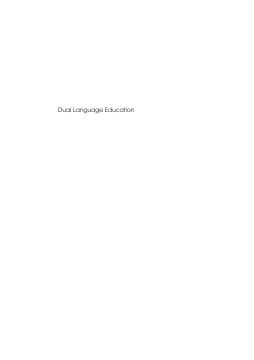
Additional Information
Book Details
Abstract
Dual language education is a program that combines language minority and language majority students for instruction through two languages. This book provides the conceptual background for the program and discusses major implementation issues. Research findings summarize language proficiency and achievement outcomes from 8000 students at 20 schools, along with teacher and parent attitudes.
Kathryn Lindholm-Leary is Professor of Child Development in the College of Education at San Jose State University in San Jose, California, where she teaches courses in child development, educational psychology, multicultural education, and research. She has worked in evaluating and assisting in the implementation of over 100 dual language education programs covering several states in the US over the past 15 years. Dr. Lindholm-Leary has authored books and articles discussing theory, implementation issues and research results related to dual language education.
Table of Contents
| Section Title | Page | Action | Price |
|---|---|---|---|
| Contents | v | ||
| Acknowledgments | vii | ||
| Introduction | 1 | ||
| Part 1 Social and Theoretical Contexts of Dual Language Education | 7 | ||
| Chapter 1 Language Education Programs and Politics | 9 | ||
| Chapter 2 Theoretical and Conceptual Foundations for Dual Language Education Programs | 39 | ||
| Chapter 3 Critical Features of Successful Language Education Programs: Design and Implementation Issues | 59 | ||
| Part 2 Classroom, Administrative and Familial Contexts in Dual Language Education | 77 | ||
| Chapter 4 The Dual Language Education School Characteristics and Data Collection | 79 | ||
| Chapter 5 Teacher Background and Perceptions of Support, Program Planning, Instructional Practices and Efficacy | 96 | ||
| Chapter 6 Teacher Talk in Dual Language Education Classrooms | 123 | ||
| Chapter 7 Parent Involvement, Attitudes and Satisfaction in Dual Language Education Programs | 143 | ||
| Part 3 Student Outcomes in Dual Language Education Programs | 169 | ||
| Chapter 8 Student Outcomes: Introduction and Data Collection | 171 | ||
| Chapter 9 Student Outcomes: Oral Language Proficiency | 179 | ||
| Chapter 10 Student Outcomes: Academic Language Proficiency – Reading and Language Achievement | 207 | ||
| Chapter 11 Student Outcomes in Reading and Literacy: Standardized Achievement Tests vs. Alternative Assessment | 234 | ||
| Chapter 12 Student Outcomes: Content Area Achievement in Mathematics, Science and Social Studies | 247 | ||
| Chapter 13 Student Outcomes: Attitudes | 271 | ||
| Part 4 Conclusions and Implications for Language Education Programs | 289 | ||
| Chapter 14 Summary and Conclusions | 291 | ||
| Chapter 15 Implications | 310 | ||
| Appendix | 331 | ||
| References | 343 | ||
| Index | 366 |
